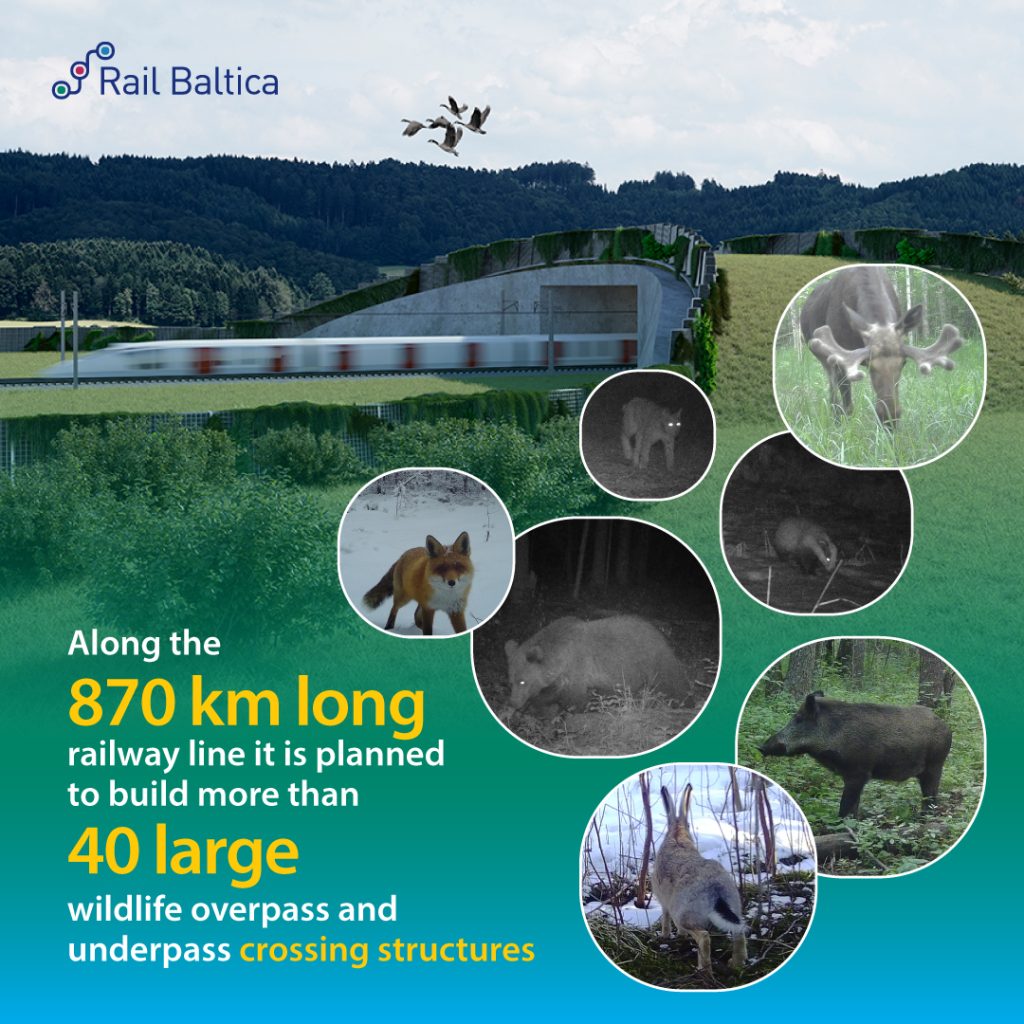A two-year monitoring of mammals, including predators, has completed in order to develop the best solution for safe crossing of railway tracks for animals. In line with the program by the Nature Conservation Agency, from 2020 to 2022, wildlife monitoring has been implemented in pre-construction phase in all four sections of the Rail Baltica route in Latvia. In the section from the Estonian and Latvian border to Vangaži, mammals were also observed with video cameras. During this period, the respective area was visited by variety of wildlife, including wild boars, deer, moose, bears, foxes, wolves, racoon dogs and lynxes, as well as small mammals like squirrels, hares, martens, and others.
“The data, obtained in the almost 2-year-long monitoring, is essential in designing safe crossing ways along the new railway. By understanding where and how mammals move through the landscape, we can develop effective solutions to mitigate our impact on these species,” says Iveta Jēgere, Spatial Planning and Environmental Team Leader at RB Rail AS.
One of the mandatory procedures during the design phase is an environmental impact assessment which examines various factors that affect wildlife in the vicinity of the new railway line. Part of it is monitoring mammals and their migration paths and breeding areas to develop the best solution for safe animal migration. It is recommended to carry out mammal monitoring in three stages: pre-construction, during construction, and post-construction. This approach facilitates the comparison of data across these stages, allowing for the identification of potential changes and causes, and enabling informed decisions regarding additional measures to be taken.
During the design of Rail Baltica, a mammal monitoring program was developed and approved by the Nature Conservation Agency for the section of Rail Baltica future railway line on the territory of Latvia, which defines the types of monitoring, their objectives, tasks and methodologies.
To effectively monitor large and medium-sized mammals, including large predators, a variety of techniques are employed. While video cameras and photo traps capture important data, experts also conduct surveys using established routes to analyze incoming and outgoing tracks, as well as local corridors and feeding and recreation areas. Additionally, the inventory of excrement provides valuable information on population density and composition. These surveys are conducted twice a year, in winter, when the snow cover has formed, and in spring, after the snow melts, but before the formation of vegetation. Depending on the species being monitored, different techniques may be employed, such as the use of specially-designed nest box with removable roof or rear wall for identifying population of dormouse.
The findings from the two-year monitoring and expert analysis substantiate the location selection of passages for large and medium-sized mammals, while also identifying areas where culverts need to be adjusted to enable small mammals, such as otters, to navigate across the railway track. In the section from the Estonia-Latvia border to Vangaži, six ecoducts and an underpass are planned to be constructed to facilitate large and medium-size mammal migration. According to the current estimates, more than 40 large wildlife passages – both overpasses and underpasses – will be built across the 870-kilometer railway line.

Additional information:
As the most environmentally friendly and safest means of transport rail can have a significant impact in reducing the environmental footprint, and Rail Baltica aims to provide sustainable and efficient mode of transportation for the Baltic region. At the same time, while designing and constructing a megaproject, it is crucial to minimize any adverse effects on different aspects of the ecosystem.
Transport is one of the major sources of pollution in the Baltic region, and in the whole EU, reducing substantially the air quality in our cities and posing threats to the ecosystem and human health. As the second largest greenhouse gas-emitting sector after energy production, it accounts for almost a quarter of Europe’s greenhouse gas emissions. The European Grean Deal, a shared commitment by the EU member states for Europe to become climate-neutral by 2050, among other initiatives makes an increased use of rail a cornerstone of its carbon neutrality and low-emission mobility ambition.
After its completion Rail Baltica will not only make travelling in the Baltics much faster and more comfortable but will also significantly contribute to the region’s climate neutrality targets. As the most important cross-border railway infrastructure development in the Northeastern Europe, Rail Baltica has set an ambitious goal of working towards achieving zero environmental impact during the operation and maintenance phase and, as early as 2018, has taken significant steps towards turning this vision into a comprehensive program. This program aims to extend beyond greenhouse gas emissions, tackling all types of impacts on the environment caused by railway infrastructure, including the use of renewable energy, the organization of environmentally responsible construction works, including the ones impacting human health such as the reduction of rail noise and vibration levels, and the general reduction of the consumption of environmental resources.
